Morphology, Rheological and Mechanical Properties of Isotropic and Anisotropic PP/rPET/GnP Nanocomposite Samples
Abstract
:1. Introduction
2. Materials and Methods
3. Results and Discussion
4. Conclusions
Supplementary Materials
Author Contributions
Funding
Institutional Review Board Statement
Informed Consent Statement
Data Availability Statement
Conflicts of Interest
References
- Paul, D.R.; Barlow, J.W. Polymer blends (or Alloys). J. Macromol. Sci. Part C 1980, 18, 109–168. [Google Scholar] [CrossRef]
- Utracki, L.A.; Wilkie, C.A. Polymer Blends Handbook; Springer: Berlin/Heidelberg, Germany, 2002. [Google Scholar]
- Alexandre, M.; Dubois, P. Polymer-layered silicate nanocomposites: Preparation, properties and uses of a new class of materials. Mater. Sci. Eng. 2000, 28, 1–63. [Google Scholar] [CrossRef]
- Shameem, M.M.; Sasikanth, S.M.; Annamalai, R.; Raman, R.G. A brief review on polymer nanocomposites and its applications. Mater. Today Proc. 2021, 45, 2536–2539. [Google Scholar] [CrossRef]
- Shahrokh, A.; Fakhrabadi, M.M.S. Effects of copper nanoparticles on elastic thermal properties of conductive polymer nanocomposites. Mech. Mater. 2021, 160, 103958. [Google Scholar] [CrossRef]
- Hajibeygi, M.; Mousavi, M.; Shabanian, M.; Habibbnejad, N.; Vahabi, H. Design and preparation of new polypropylene/magnesium oxide micro particles composites reinforced with hydroxyapatite nanoparticles: A study of thermal stability, flame retardancy and mechanical properties. Mater. Chem. Phys. 2021, 258, 123917. [Google Scholar] [CrossRef]
- Lopez-Gonzalez, M.; Flores, A.; Marra, F.; Ellis, G.; Gomez-Fatou, M.; Salvagione, H.J. Graphene and polyethylene: A strong combination toward multifunction nanocomposites. Polymers 2020, 12, 2094. [Google Scholar] [CrossRef]
- Zhao, X.; Zhang, Q.; Chen, D.; Lu, P. Enhanced mechanical properties of graphene-based poly (vinyl alcohol) composites. Macromolecules 2010, 43, 2357–2363. [Google Scholar] [CrossRef]
- La Mantia, F.P.; Ceraulo, M.; Mistretta, M.C.; Botta, L. Effect of the elongational flow on morphology and properties of polypropylene/graphene nanoplatelets nanocomposites. Polym. Test. 2018, 71, 10–17. [Google Scholar] [CrossRef]
- Mistretta, M.C.; Botta, L.; Vinci, A.D.; Ceraulo, M.; La Mantia, F.P. Photo-oxidation of polypropylene/graphene nanoplatelets. Polym. Degrad. Stab. 2019, 160, 35–42. [Google Scholar] [CrossRef]
- Botta., L.; La Mantia, F.P.; Ceraulo, M.; Mistretta, M.C. Effect of processing temperature and mixing time on the properties of PP/GnP nanocomposites. Polym. Degrad. Stab. 2020, 181, 109321. [Google Scholar] [CrossRef]
- Liu, Y.; Lu, J.; Cui, Y. Improved thermal conductivity of epoxy resin by graphene-nickel three-dimensional filler. Carbon Resour. Convers. 2020, 3, 29–35. [Google Scholar] [CrossRef]
- Li, Y.; Zhang, H.; Porwal, H.; Huang, Z.; Bilotti, E.; Peijs, T. Mechanical, electrical and thermal properties of in-situ exfoliated graphene/epoxy nanocomposites. Compos. Part A Appl. Sci. Manuf. 2017, 95, 229–236. [Google Scholar] [CrossRef]
- Uyor, U.; Popoola, A.P.I.; Popoola, O.M.; Aigboidion, V.S. Influence of graphene-carbon nanotubes and processing parameters on electrical and dieletric properties of polypropylene nanocomposite. J. Compos. Mater. 2021, 55, 3013–3022. [Google Scholar] [CrossRef]
- Roeder, J.; Oliviera, R.V.B.; Goncalves, M.C.; Soldi, V.; Pires, A.T.N. Polypropylene/polyamide-6blends: Influence of compatibilizing agent on interface domains. Polym. Test. 2012, 21, 815–821. [Google Scholar] [CrossRef]
- Campoy, I.; Arribas, J.M.; Zaporta, M.A.M.; Marco, C.; Gomez, M.A.; Fatou, J.G. Crystallization kinetics of polypropylene-polyamide compatibilized blends. Eur. Polym. J. 1995, 31, 475–480. [Google Scholar]
- La Mantia, F.P. Blends of polypropylene and Nylon 6: Influence of compatibilizer, Molecular weight and processing conditions. Adv. Polym. Tech. 1993, 12, 47–59. [Google Scholar] [CrossRef]
- Thakre, A.R.; Baxi, R.N.; Walke, P.V.; Gupta., P. Mechanical and thermal behavior of PP/PET blends. Int. J. Innov. Eng. Sci. 2018, 3, 2456–3463. [Google Scholar]
- Kordjazi, Z.; Ebrahimi, N.G. Rheological behavior of non-compatibilized and compatibilized PP/PET blends with SEBS-g-MA. J. Appl. Polym. Sci. 2009, 116, 441–448. [Google Scholar] [CrossRef]
- La Mantia, F.P.; Ceraulo, M.; Giacchi, G.; Mistretta, M.C.; Botta, L. Effect of compatibilizer on the morphology and properties of polypropylene/polyethylenetherephthalate spun fibers. Polymers 2016, 9, 47. [Google Scholar] [CrossRef]
- Calcagno, C.I.W.; Mariani, C.M.; Teixera, S.R.; Mauler, R.S. The role of the MMT on the morphology and mechanical properties of the PP/PET blends. Compos. Sci. Technol. 2008, 68, 2193–2200. [Google Scholar] [CrossRef]
- Li, W.; Karger-Kocsic, J.; Thoman, R. Compatibilization effect of TiO2 nanoparticles on the phase structure of PET/PP/ TiO2 nanocomposites. J. Polym. Sci. B Polym. Phys. 2009, 47, 1616–1624. [Google Scholar] [CrossRef]
- Inuwa, I.M.; Hassan, A.; Samsudin, S.A.; Mohamed Haafiz, M.K.; Jawaid, M.; Majeed, K.; Abdul Razak, N.C. Characterization and mechanical properties of exfoliated graphite nanoplatelets reinforced polyethylene terephthalate/polypropylene composites. J. Appl. Polym. Sci. 2014, 131, 40582. [Google Scholar] [CrossRef]
- Inuwa, I.M.; Hassan, A.; Wang, D.Y.; Samsudin, S.A.; Haafiz, M.K.; Wong, S.I.; Jawaid, M. Influence of exfoliated graphite nanoplatelets on the flammability and thermal properties of polyethylene terepthalate/polypropylene nanocomposites. Polym. Degrad. Stab. 2014, 110, 137–148. [Google Scholar] [CrossRef]
- ASTM D1238-20. Standard Test Method for Melt Flow Rates of Thermoplastics by Extrusion Plastometer; ASTM International: West Conshohocken, PA, USA, 2020. [Google Scholar]
- ASTM D638-14. Standard Test Method for Tensile Properties of Plastics. Available online: http://www.dept.aoe.vt.edu/~aborgolt/aoe3054/manual/expt5/D638.38935.pdf (accessed on 3 October 2021).
- La Mantia, F.L.; Arrigo, R.; Morreale, M. Effect of the orientation and rheological behavior of biodegradable polymer nanocomposites. Eur. Polym. J. 2014, 54, 11–17. [Google Scholar] [CrossRef]
- Mistretta, M.C.; Morreale, M.; Botta, L.; Ceraulo, M.; Fontana, P.; La Mantia, F.P. Compatibilization through elongational flow processing of LDPE/PA6 blends. Materials 2018, 12, 2375. [Google Scholar] [CrossRef] [PubMed] [Green Version]
- Krishnamoorti, R.; Yurekli, K. Rheology of polymer layered silicate nanocomposites. Curr. Opin. Colloid Interface Sci. 2001, 6, 464–470. [Google Scholar] [CrossRef]
- Ren, J.; Krishnamoorti, R. Nonlinear Viscoelastic Properties of Layered-Silicate-Based Intercalated Nanocomposites. Macromolecules 2003, 36, 4443–4451. [Google Scholar] [CrossRef]
- Scaffaro, R.; Botta, L.; Maio, A.; Gallo, G. PLA graphene nanoplatelets nanocomposites: Physical properties and release kinetics of an antimicrobial agent. Compos. Part B Eng. 2017, 109, 138–146. [Google Scholar] [CrossRef]
- La Mantia, F.P.; Ceraulo, M.; Testa, P.; Morreale, M. Biodegradable Polymers for the Production of Nets for Agricultural Products Packaging. Materials 2021, 14, 323. [Google Scholar] [CrossRef]
- Mistretta, M.C.; Botta, L.; Arrigo, R.; Malucelli, G.; La Mantia, F.P. Bionanocomposite blown films: Insights on the rheological and mechanical behavior. Polymers 2021, 13, 1167. [Google Scholar] [CrossRef]

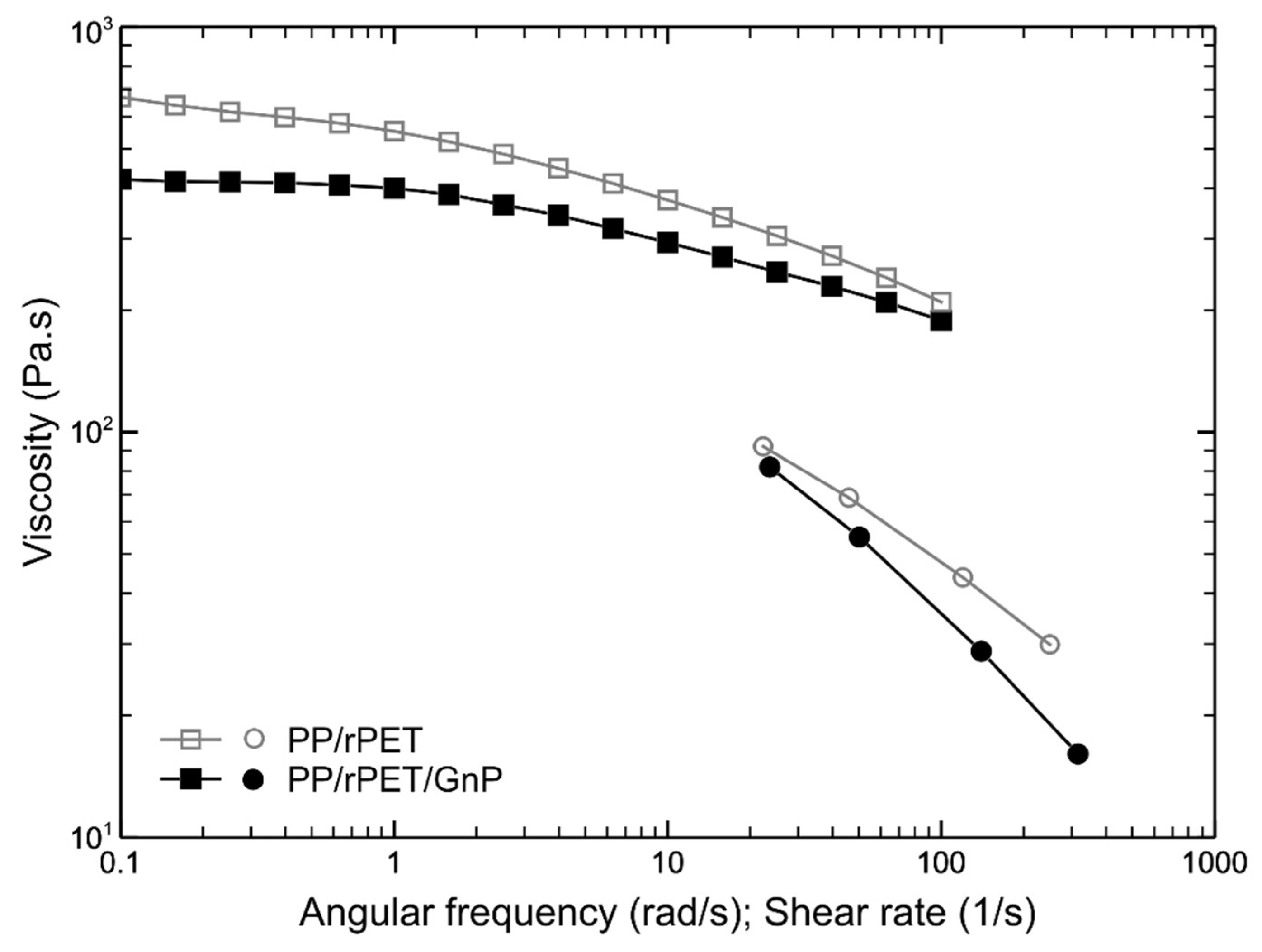
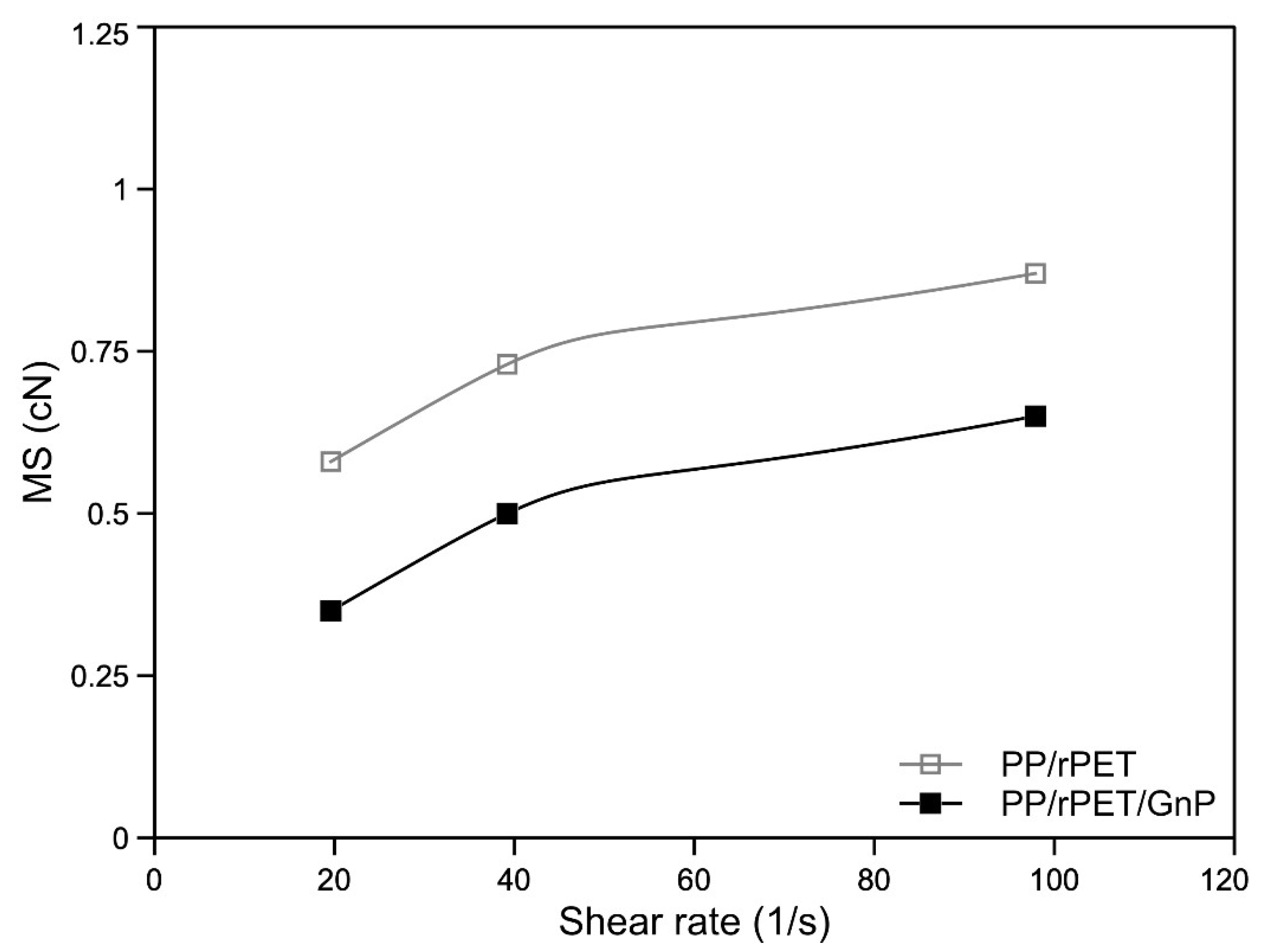
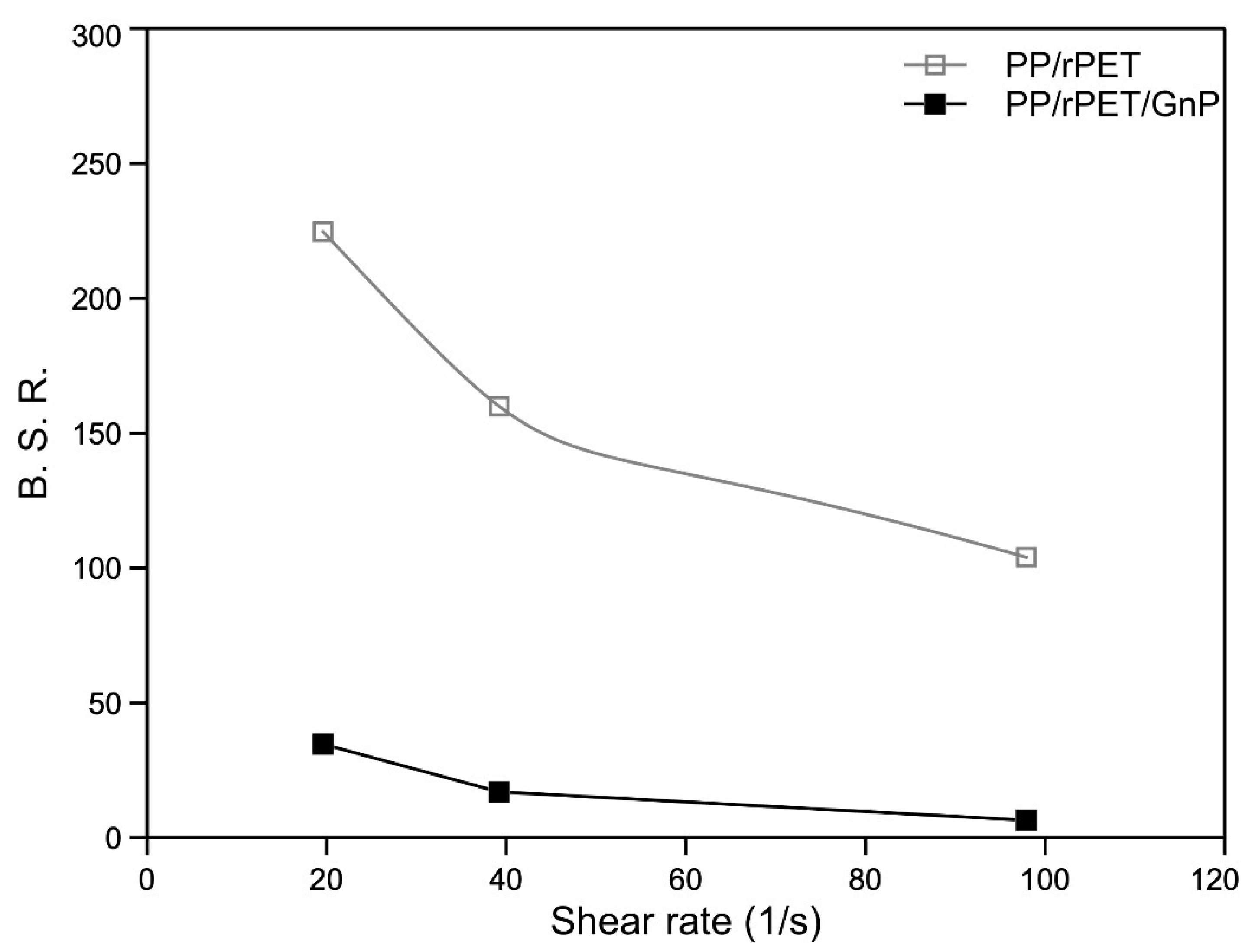
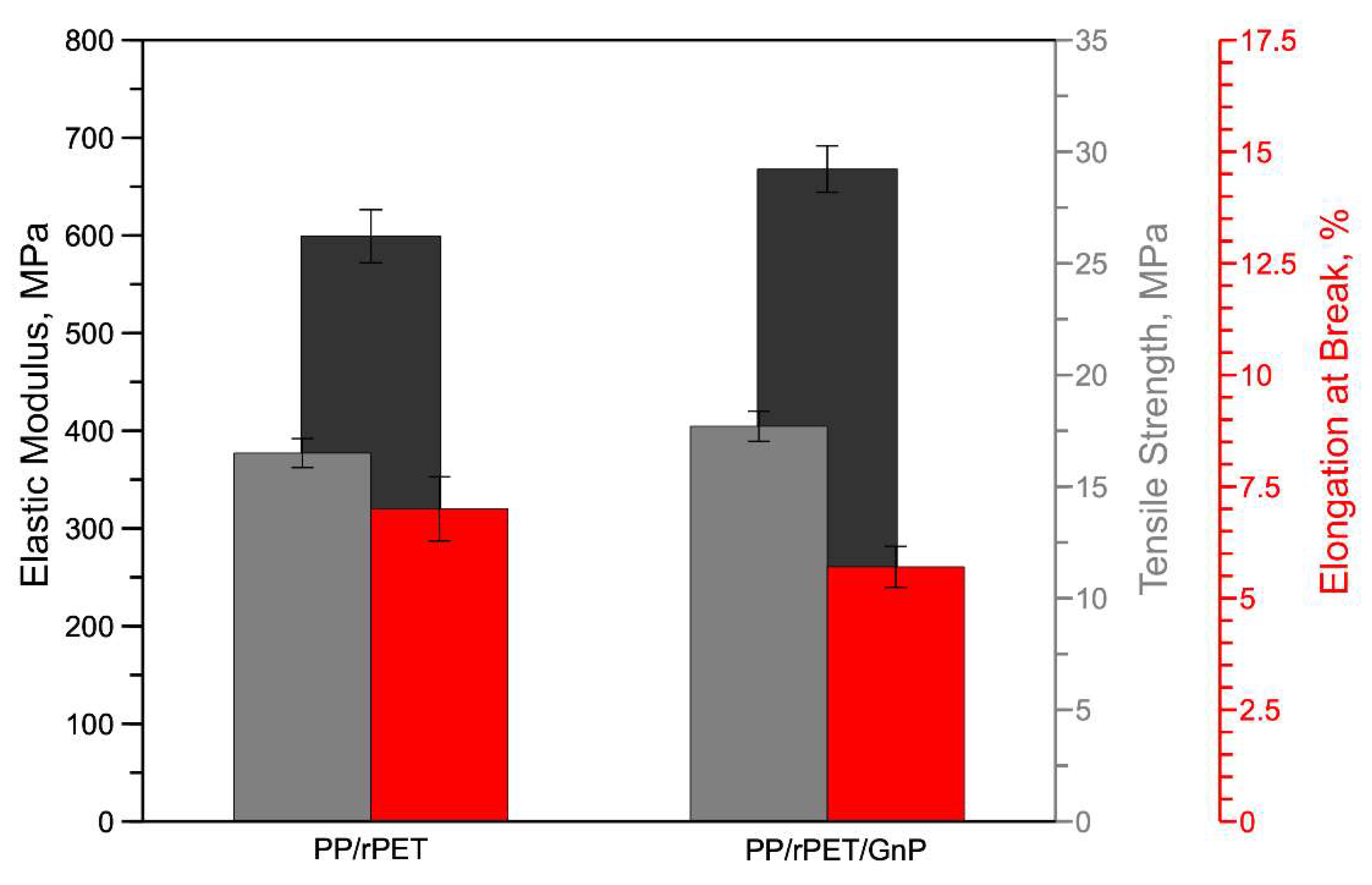


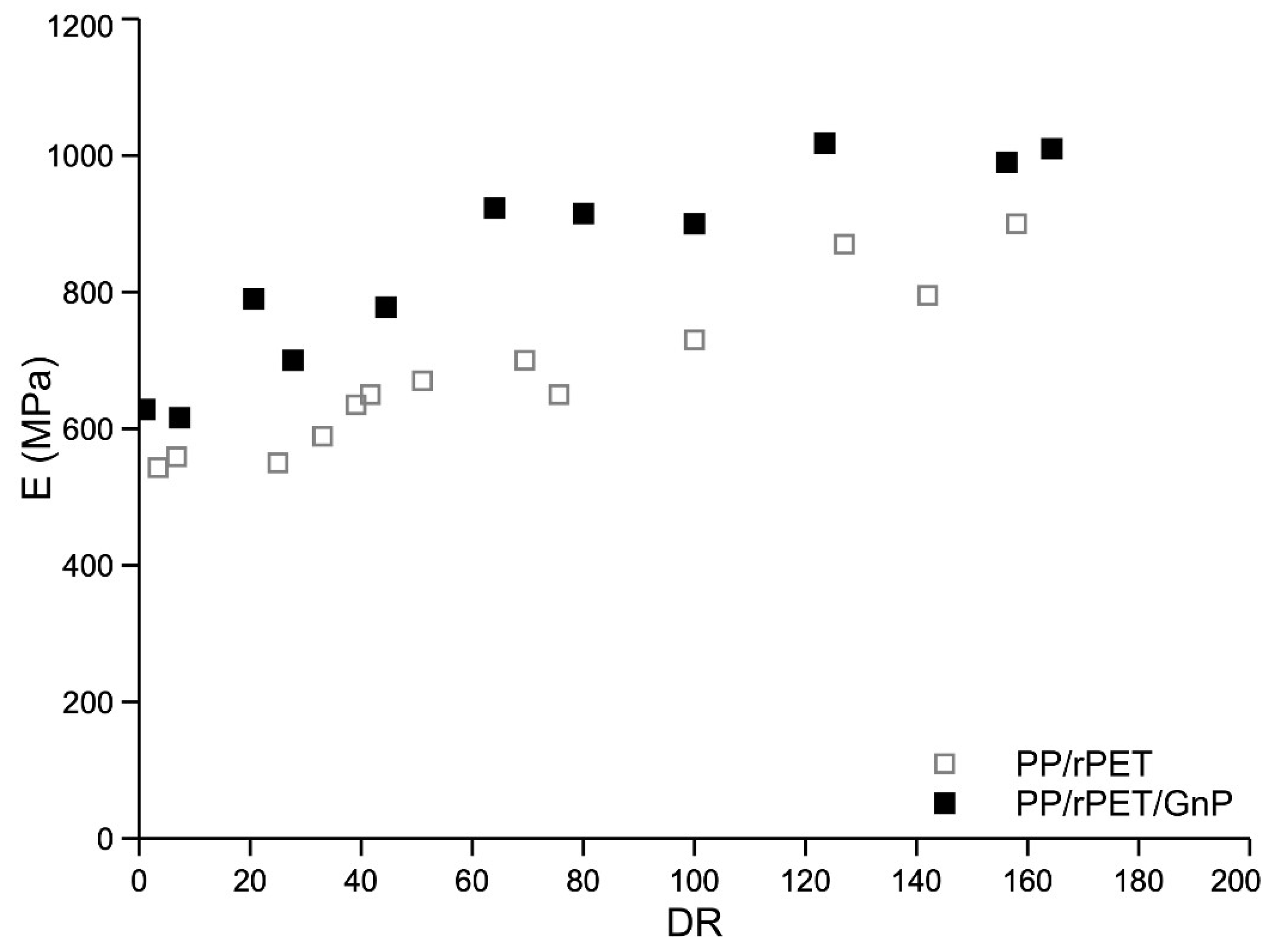
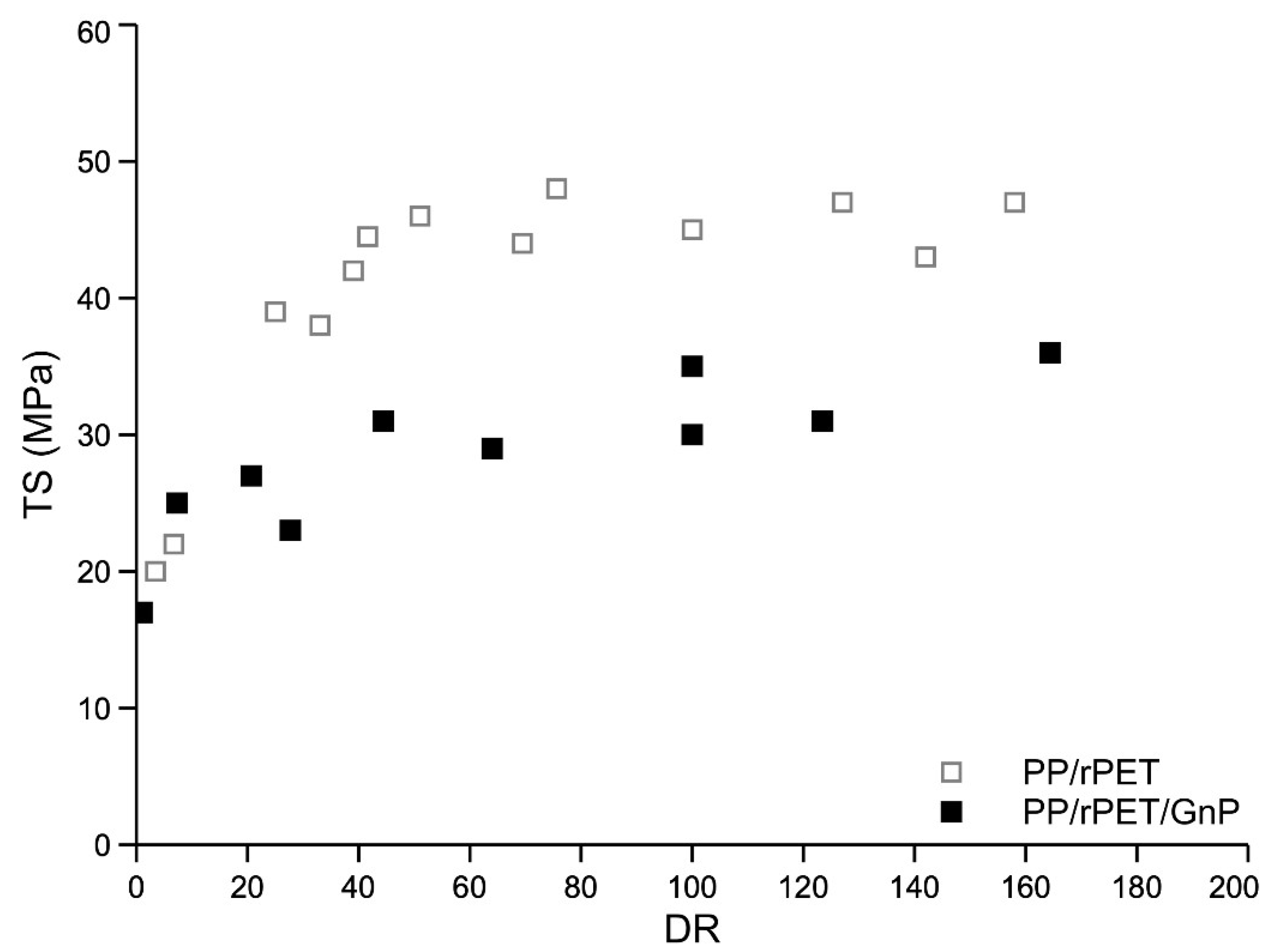
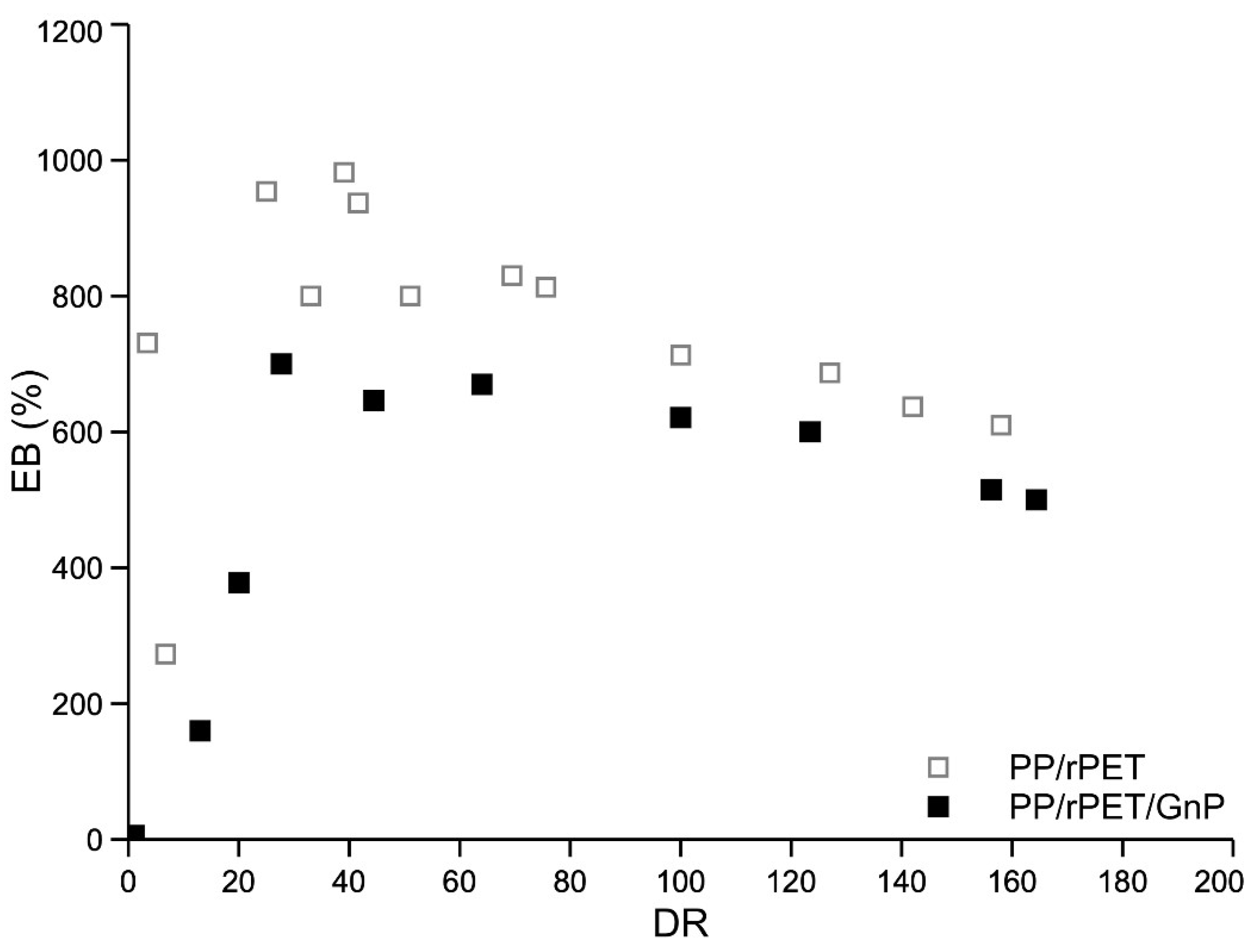
| Blends | PP (wt %) | rPET (wt %) | GnP (wt %) |
|---|---|---|---|
| PP/rPET | 75 | 25 | - |
| PP/rPET/GnP | 75 | 25 | 2 |
Publisher’s Note: MDPI stays neutral with regard to jurisdictional claims in published maps and institutional affiliations. |
© 2021 by the authors. Licensee MDPI, Basel, Switzerland. This article is an open access article distributed under the terms and conditions of the Creative Commons Attribution (CC BY) license (https://creativecommons.org/licenses/by/4.0/).
Share and Cite
Mantia, F.P.L.; Titone, V.; Milazzo, A.; Ceraulo, M.; Botta, L. Morphology, Rheological and Mechanical Properties of Isotropic and Anisotropic PP/rPET/GnP Nanocomposite Samples. Nanomaterials 2021, 11, 3058. https://doi.org/10.3390/nano11113058
Mantia FPL, Titone V, Milazzo A, Ceraulo M, Botta L. Morphology, Rheological and Mechanical Properties of Isotropic and Anisotropic PP/rPET/GnP Nanocomposite Samples. Nanomaterials. 2021; 11(11):3058. https://doi.org/10.3390/nano11113058
Chicago/Turabian StyleMantia, Francesco Paolo La, Vincenzo Titone, Alessandro Milazzo, Manuela Ceraulo, and Luigi Botta. 2021. "Morphology, Rheological and Mechanical Properties of Isotropic and Anisotropic PP/rPET/GnP Nanocomposite Samples" Nanomaterials 11, no. 11: 3058. https://doi.org/10.3390/nano11113058
APA StyleMantia, F. P. L., Titone, V., Milazzo, A., Ceraulo, M., & Botta, L. (2021). Morphology, Rheological and Mechanical Properties of Isotropic and Anisotropic PP/rPET/GnP Nanocomposite Samples. Nanomaterials, 11(11), 3058. https://doi.org/10.3390/nano11113058









